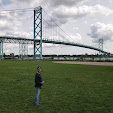After more than 28 years of being moored at Pier 82 on the Delaware River in South Philadelphia, the former ocean liner SS United States is on the move again. The liner departed under tow from Philadelphia on Wednesday, February 19, bound for the port of Mobile, AL, where the ship will be prepared for deployment as an artificial reef off the coast of the Florida panhandle in the coming months.
The journey to this day has been more than 50 years in the making and the whole story of the ship's history is beyond the scope of this post, however some backstory is necessary in order to set the scene for what took place on Wednesday. (That journey *is* the subject of a forthcoming article for this blog in the coming weeks.) The United States is simply the greatest ship conceived and built for the American merchant fleet in the country's history. On her maiden voyage in July 1952, she broke the transatlantic speed record with a time that was more than 10 hours faster than the previous record, crossing the Atlantic from New York to the English Channel in less than three and a half days, winning the prestigious Blue Riband in the process. The ship was designed by American naval architect William Francis Gibbs and much of the ship's design was classified by the U.S. Navy. In spite of its stated objective of serving as a transatlantic ocean liner, the ship was designed and built to strict naval specifications, because of the U.S. Government's desire to build a ship that could easily be transformed into a troop transport in the event of war. Fortunately the liner never served in this wartime role, although she was placed on standby during the Cuban Missile Crisis of 1962. Otherwise, her commercial career was uneventful and she sailed her last commercial voyage in November 1969.

The SS United States, shown in this 2024 photo, had been moored on the Delaware River for nearly 30 years as it awaited a new life as a static tourist attraction - an idea that never came to be.
In the ensuing 56 years, there were many attempts to bring the ship back to life in one form or another. The liner had been docked at Pier 82 on the Delaware River since July 1996 and has passed through different owners in the nearly three decades since. The ship's most recent owner, the non-profit "SS United States Conservancy", had been in discussions with architects and officials about converting the ship into a static tourist attraction at a waterfront location somewhere on the American east coast. For a variety of reasons, these plans fell through and with the Conservancy facing eviction from their South Philadelphia pier, the decision was made to sell the ship in October 2024 to Okaloosa County, Florida. Florida officials intend to turn the ship into an underwater tourist destination for scuba divers while also creating the world's single largest artificial reef for the protection of marine life.
Once the ship arrives in Mobile, work will begin to salvage important pieces of the superstructure and hull. Even though the ship was completed abated in the early 1990s, there are still some hazardous materials on board that need to be safely removed before the ship can be sunk. Okaloosa County officials are optimistic that the necessary work will be completed in time for the ship to be sunk about 20 miles off the coast of Destin/Fort Walton Beach, FL in early 2026. In addition to the liner's deployment in this manner, Okaloosa County is planning a land-based museum (in conjunction with the ship's previous owner, the SS United States Conservancy) to be located in the Destin/Fort Walton Beach area. It is hoped that the museum, which is still in the planning stage, will be a fitting tribute to what is undeniably the single greatest merchant marine achievement in American history.
I had the privilege of documenting this historic moving day on the Delaware River and I offer a few of my photos from the day below. It was an emotional experience for someone like me, who has had a fascination with this ship ever since she arrived in Philadelphia more than 28 years ago. Click on each photo to see a larger version.

Maneuvering the SS United States into the Delaware River near the Walt Whitman Bridge in South Philadelphia






Comments